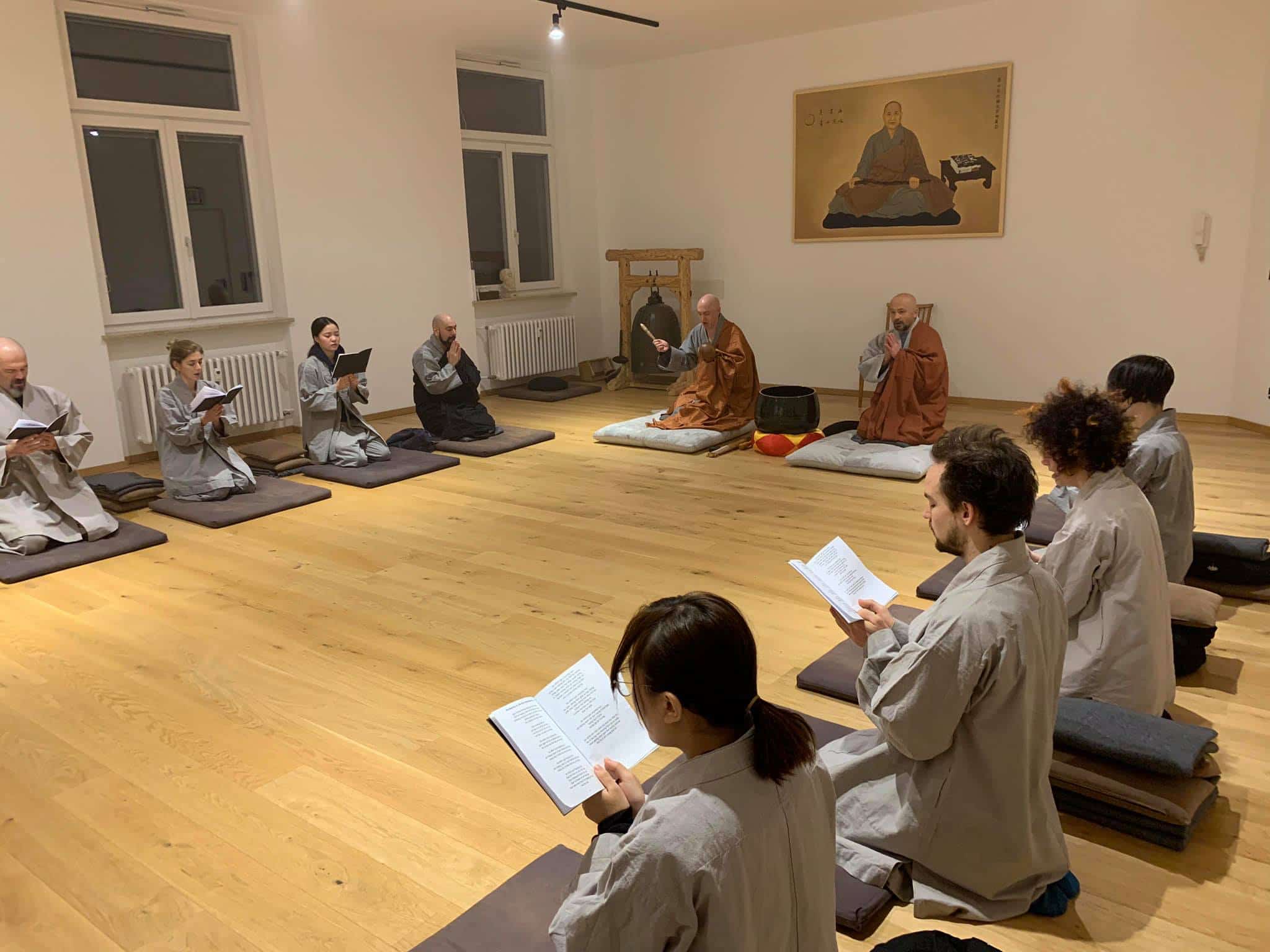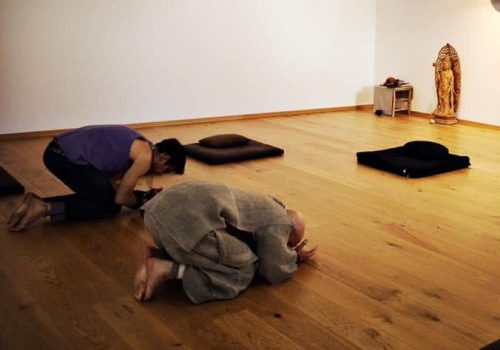Meditation
Meditation

Zen meditation means attaining our True Self. In this way, we can say that meditation is about “returning”: Returning from this hectic world of thinking, over-thinking, and blind, unfocused desire (appointments, deadlines, stress and worries, memories, fear) to the place of perfect stillness before thinking arises, sometimes called “true nature,” “true self,” “original nature,” or “don’t-know mind.”
Zen is the simple action of letting our present attention — that is, when left to habit, often constantly following our thoughts — just return naturally to this moment, its original home. Letting it settle here, watching our breath, inhaling and exhaling, like the movement of ocean waves, we return to our original boundless awareness.
So, Zen is not special. When you walk, only walk. When you eat, only eat. Salt is salty; sugar is sweet. It’s very simple. But understanding this is not enough: we must attain this point in order for it to function effortlessly in our lives.
In order to attain the point of Zen, it is very helpful if one builds a consistent daily practice, especially in the beginning. In this tradition of Zen, we rely on the large practice-technologies of sitting meditation, walking meditation, chanting meditation, and bowing. Let’s now talk about each one of these in some detail:
Sitting Meditation
Let’s say that you want to take a nice photograph in poor lighting. This is called taking a “long-exposure” photo. For that, you need a good camera, but you also need to establish this camera on a stable tripod. If you do not set your camera on a good tripod, then even if your camera is very high-class, very expensive, it will be shaky, and it will not catch a clear image.
The same is true of our lives: always moving, moving, moving, coming and coming from thought to thought, and from situation to situation, we do not rest long enough to “catch” a clear insight into our mind. Sitting Zen is the basic tripod-posture for taking a long-exposure photograph of our life.
Here are some basic instructions for sitting Zen:
Try to find a position in which your knees are slightly lower than your hips. That ensures that your back alone doesn’t need to hold all your weight. There are a lot of possible positions, because we all have different conditions and histories with our bodies. The most important thing is keeping don’t-know mind with awareness of breath: the posture need not be some picture-perfect ideal. “Body-sitting is not so important,” Zen Master Seung Sahn used to say. “Mind-sitting is very important.”
You are also allowed to stand up quietly during sitting meditation if you are experiencing great difficulties of any kind.
We try to keep the back straight, but not in a tight way. If you are sitting cross-legged on a mat, use the edge of a cushion as a wedge to gently lift the base of the spine. When sitting in a chair, do not slump the shoulders forward, but use a cushion or pillow down at the base of the spine to encourage the gentler, natural curvature of the lower back.
In both postures, correct support for the lower spine helps with the natural curvature of the lower back, allowing the shoulders and upper back to remain gracefully straight, without special effort.
Zen means “wake up!” So, in Zen practice, we meditate with eyes open, gazing softly forward from the edge of the mat on the floor in front of us. Some people who come to the Zen Center have learned elsewhere to meditate with eyes closed, and you may continue that practice during your visits, of course, but we do not encourage that as part of the regular training here.
- All other senses are open. You hear, smell, taste, and feel sensations of the body during meditation. Why cut off just one sense?
- Meditating with eyes closed encourages sleep to come easier: the line between wakefulness and sleep is not always entirely clear. Drifting in and out of these states, we cannot easily maintain natural wakefulness and clarity.
So why eyes down? The mind is used to getting distracted, so our eyes are constantly looking for that. Bringing them down to the ground takes away that visual distraction.
Mahamudra is the “method” taught in the Zen tradition.
Mahamudra: Place the hands above or in your lap, the left hand facing palm-up resting in the right hand, and connect the tips of your thumbs gently. This is placed in front of your “center,” or dan jeon (Jap.: Hara). It’s a very natural resting position for your arms.
Far more than that, the resting of your fingertips together at the gravitational-center of your body/mind is a kind of “trick” to attract the subtle strands of thinking-consciousness down to the breathing-center.
Lots of moving and adjusting will not help your practice, and it will disturb others. Maybe the guy sitting right next to you in the movie theater will feel a lot better about his movie experience if he can just slowly munch through a loud, plasticky bag of potato chips and slurp his oversized Coke and crack his fingers from time to time. But will that enhance your own movie-going experience?
The same applies for our Dharma Room etiquette. We don’t need to be wooden robots, by any measure. But having clear body-awareness helps your own meditation’s growth and the practice of others.
It’s normal that your knee or back will start to hurt a little. In the beginning try to continue meditating, very often it passes away again. If the pain becomes too problematic, half-bow once as a silent-courtesy, stand up carefully and walk behind your cushion until your knees/back, whatever, are better again.
Attention to breath is central to all true meditation traditions and schools. In Zen, we practice with awareness of breath: soft attention to your breathing, to that natural rising and falling flow of inhalation and exhalation that happens automatically. When a thought comes and drags you with it, just notice that, let go of it, and return to your breath again.
(An important point: We do not teach people to “concentrate” on the breath, or “focus” on the breath. Both of these actions have tension, holding, and cannot be maintained for long. “Awareness” of breath is not the same as “concentrating” or “focusing” on breath.)
It’s like learning how to surf. You get on your board and try to stay there. If a wave comes that throws you off, you just get back on. By doing that over and over again, your position on the board will get stronger. You will not arrive at stability on the board through tensing up, or on “focusing” on the wave or “concentrating” on the board. There is just this soft, natural awareness of the flowing wave of breath that we return to, which brings us back to right-here-right-now.
“Why was I born? Why must I die? Why is there suffering in the world? What is my life? What am I?” Human beings have a question about their existence. But most do not look into the question, and instead cover it up with distractions and an endless stream of mindless sensory diversions, which then become attachment: suffering.
Through Zen practice, we engage the naturally arising question of our existence, through the natural movement of breath: “What/who sits here? What/who sees my breath… happening? What/who sees these thoughts, appearing and disappearing? Where does this thinking arise from?” “What is the witness?”
We do not “ask” this conceptually, or with our thinking-mind: it is the natural questioning/watching that we have about life and death. “What am I?”
When we really look into this question, all thinking is naturally cut off: we return to our mind before thinking arises. Thinking cannot go there. There is only don’t knowwwwww…

Walking Meditation
Walking meditation is a very good, practical (and healthy!) method for bringing the power of sitting-practice into our everyday lives. Follow the group with the speed — not too slow, not too fast. Eyes are relaxed, gazing downward and in front, not sightseeing around the room.

Carry your hands in front of you, at about belt-buckle level, fingers interlaced, so your arms don’t swing back and forth. This brings natural, soft attention down through your fingertips into your “center,” or dan jeon/hara, the energy-point of our breath-roots located just below the navel.
Except for some unforeseen emergency, we only get up to use the bathroom during walking meditation. Just bow before leaving or entering the Dharma Room and remember your position in line, so you can enter there when you come back again. This keeps the appropriate mindfulness-atmosphere in the Dharma Room and among your fellow-practitioners.
If, due to some emergency, you need to leave the Dharma Room for the bathroom (or some other reason), you will not be permitted to re-enter until the next walking meditation period. This is done, well, for the very same reason that we are not permitted to freely come and go from a concert hall during a classical music program: only during intermissions. Constant movement disturbs the atmosphere, and encourages an unsettled mind to make more things to attach to, instead of listening to the deep “music” of our True Nature.
Chanting Meditation
There are many technologies to Zen: sitting meditation, walking meditation, bowing meditation, mantra meditation, eating meditation, work meditation — why not chanting meditation? Every human culture uses the voice as a tool for people to gain deeper clarity and insight into their True Nature.
You will also learn how to meditate, while using your voice, which makes it easier to integrate the practice into the daily life.
Hyon Gak Sunim’s Teacher, Zen Master Seung Sahn, gave an excellent explanation of chanting-practice in the classic book, Dropping Ashes on the Buddha.
Here is a link to that teaching:

Bowing Meditation
Bowing is a breathing-practice. It establishes our breathing low down in our center, out of the hustle-and-bustle of our thinking-heads. Bowing lowers the ego, and calms down the mind. As we lower our whole body to the ground, the chest is collapsed, and air comes out; as we stand up again, expanding our thoracic cavity, the air enters inward. That small gesture already helps to bring the mind into a more peaceful state. In bowing, my Small I bows to my Big I. It is not a religious or sectarian meaning.

Half Bow

Full Bow
This form around the practice might feel a little bit restrictive, but all of that is actually to free us. Giving up outer freedom to attain inner freedom.
If you don’t know what to do during practice, just look around and follow the others.
Don’t worry about doing a mistake. The only “mistake” in Zen practice is to hold your thinking, feelings, or opinions. This is true for life, for relationships with others, and so it is true for practice together in the temple.
